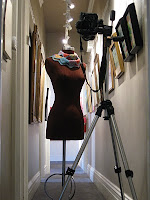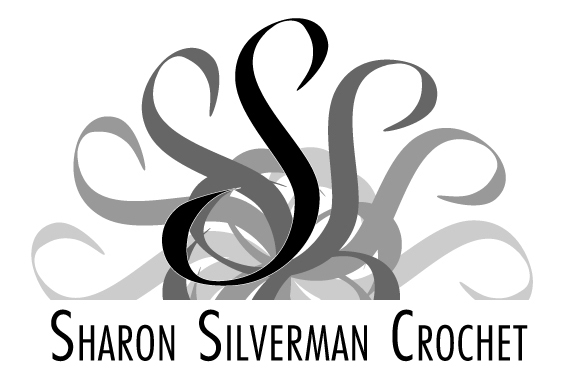 Photographs for my crochet books and patterns fall into three categories: pictures of the finished items, step-by-step photos of the techniques (called "step-outs" in the industry), and closeups of the stitch patterns to show detail. Each type of photo requires different preparation. Since I'm in the midst of going through this process for the "Crochet Scarves" book, I thought I'd share it with you.
Photographs for my crochet books and patterns fall into three categories: pictures of the finished items, step-by-step photos of the techniques (called "step-outs" in the industry), and closeups of the stitch patterns to show detail. Each type of photo requires different preparation. Since I'm in the midst of going through this process for the "Crochet Scarves" book, I thought I'd share it with you.
When the finished samples (all 23 of them!) were ready, we needed a great location to use as a backdrop. Photographer Alan Wycheck, who has photographed all of my crochet titles, had secured Mary Knackstedt's interior design studio for our last two books, but we wanted something different this time. He was able to get permission from the Art Association of Harrisburg to shoot there. It proved to be a perfect spot. Indoors, there was plenty of room to set up. The lighting was good. Architectural details and artwork livened up the pictures. We were able to use their courtyard also, and then went across Front Street to take additional shots along the waterfront in the late afternoon.
To get ready for the location shoot, I had to figure out the best way to present the scarves. Out came the trusty notebook so I could write down my styling notes and keep things moving on photo day. I have a mannequin (affectionately known as Louise) with a brown cover and a cream overlay, so first I tried the scarves on her to see which color showed off each scarf better. Then I considered dressing Louise in a top or jacket for some of the items. A denim jacket, short red trench coat, fitted white zippered jacket, and a couple of sleeveless tops looked good; the long brown trench, pale yellow quilted vest, black leather winter jacket, and royal blue riding jacket didn't. Next, I pulled out some hangers to see if draping the scarves on those would work. It took several hours and a bit of a mess in my studio to get all of the styling decisions made. Then I packed everything. Additional supplies: scissors, steam iron, fabric tape, straight pins, crochet hooks, clothing brush, and a little bit of yarn for each project just in case. And Louise, of course. Note to self: add "mosquito repellent" to packing list. Man, I was eaten alive in the Art Association's lush outdoor space.
Once on site, Wycheck (I refer to him by his last name because I have too many Alans in my life!) and I scouted the possibilities and decided which scarf to shoot in which spot. Then we went to work. It was a l-o-n-g day but extremely successful. Wycheck only had to chide me once for being impatient. (I plead extenuating circumstances: it had started to thunder.) I'm glad he does not sacrifice quality for expediency, and he makes sure I don't either!
Shooting the finished scarves was easy compared to what's on tap next. At our photo session on 9/28 we'll do the technique photos. That involves a ton of preparation on my part. As I wrote the patterns, I've been noting spots where technique pictures would be helpful. I have to have all of those pieces ready. If it's the trim, the scarf has to be crocheted up to that point. If it's Row 5, I have to have a sample that is complete through Row 4. Sometimes one pattern can require several step-outs. All of these pieces are bagged, with the yarn and with notes to remind me what I want to show, what size hook to use, and any other information that can make the photo session go smoothly. Everything is also in my notebook so I can double-check and make sure we don't miss anything.
(With still photos, there is the option to make an extra item, them rip it out and shoot the steps in reverse. Later, you can arrange the photos in the order you choose. However, when I was on Uncommon Threads television show, that wasn't an option! I think I prepared about 50 step-outs for some of the items we made on the show. It wasn't so bad making something up to the end of Row 1, then another one through Row 3, then yet another through Row 5, but having to make it through Row 157, then Row 163, then up to the trim or whatever was extremely time-consuming.)
A day or two before the technique photos are taken, I will have to decide what to do about my fingernails. Those of you who have been reading this blog for a while know that my nails are short and--although they are clean and actually don't look too bad right now--not professionally manicured. If I don't break any nails before next week I may just put a coat of clear polish on them; if things look ragged, I'll glue on fake nails and hope not to repeat the misadventures I've had with that approach in the past. Let's just say superglue and I do not get along.
On photo day, Wycheck will bring his lights, cameras, laptop, stands, and huge roll of background paper to my house. We commandeer the dining room for this enterprise. Step one, crank up the air conditioning because those lights are hot. Step two, get a stepstool for Wycheck. Mostly he perches over my shoulder and shoots down on my hands. He is a genius at showing motion in still shots, and he makes me do the stitches several times until he gets the pictures he wants. I often have to stop halfway through a stitch and then hold that position before finishing. This usually goes quite smoothly (there aren't a lot of artistic decisions to be made), but with 23 scarves and multiple step-outs for each, it takes a while.
Once that's done, we'll reward ourselves with something a little easier, taking closeups of each scarf. My job here is to make sure everything is clean and blocked, and to indicate which part(s) of every scarf should be highlighted. Since my hands aren't in the pictures, I can revert to my stylist role.
Once I have the electronic versions of the photos, it's up to me to pick which ones will be in the book. The good news: there are many wonderful pictures to choose from. The bad news: there are many wonderful pictures to choose from! Often I can toss out some right away, but it is hard to decide when it comes down to the last few. I have to insert the picture numbers into the text to tell the publisher which photos to use and where they should go. I also have to include any notes like "crop the left side," "rotate 90 degrees clockwise," or "insert arrow to point to top loop."
The package goes to Stackpole Books on October 11, and I will next see the book after it is copyedited. There will be a lot of work for me to do then, as I check word for word against the original and test the patterns to make sure they are 100% correct. In the meantime, I get a bit of a break from this large project, which I'm looking forward to. I may have to restrain myself from saying, "Tag! You're It!" when I hand in the manuscript next month.
